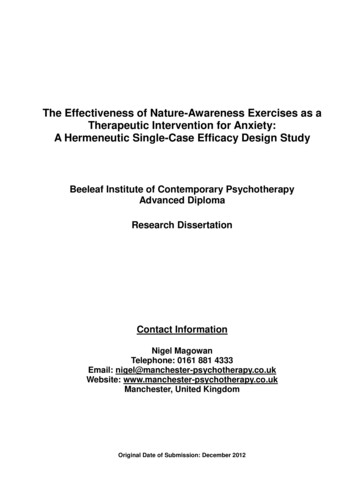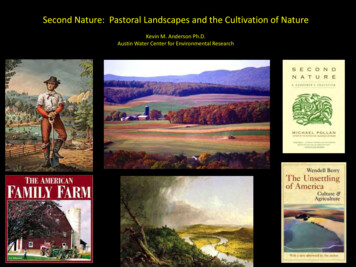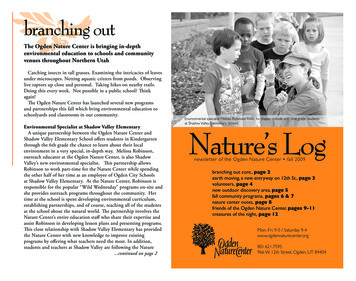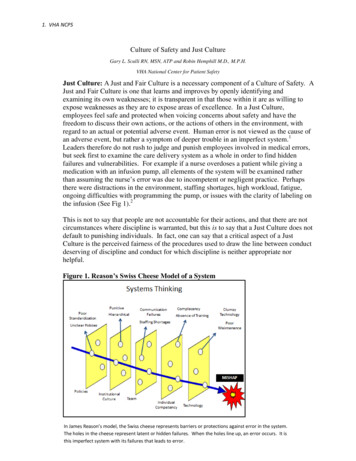
Transcription
Hypothesis and Theorypublished: 19 July 2016doi: 10.3389/fsoc.2016.00008Evoked Culture and Evoked Nature:The Promise of Gene-CultureCo-Evolution Theory for SociologyAnthony Walsh1* and Ilhong Yun2Department of Criminal Justice, Boise state University, Boise, ID, USA, 2 Department of Police Administration,Chosun University, Gwangju, South Korea1Edited by:Susanne Huber,University of Vienna, AustriaReviewed by:Joseph L. Nedelec,University of Cincinnati, USADaniel E. Adkins,Virginia CommonwealthUniversity, USA*Correspondence:Anthony Walshtwalsh@boisestate.eduSpecialty section:This article was submittedto Evolutionary Sociologyand Biosociology,a section of the journalFrontiers in SociologyReceived: 04 March 2016Accepted: 24 June 2016Published: 19 July 2016Citation:Walsh A and Yun I (2016) EvokedCulture and Evoked Nature:The Promise of Gene-CultureCo-Evolution Theory for Sociology.Front. Sociol. 1:8.doi: 10.3389/fsoc.2016.00008Frontiers in Sociology www.frontiersin.orgThe traditional sociological view of culture has been almost exclusively that of transmitted culture decoupled from biology. The concept of evoked culture brings biology“back in” since it identifies ecological challenges that evoked certain practices based onevolutionary imperatives. The practices are then passed on to subsequent generationsas normative, and individuals best suited to these normative practices will enjoy greaterfitness benefits than those less suited. In other words, practices will be transmittedgenetically as well as culturally. This paper provides several examples of how evokedand transmitted culture are tightly bound (nature evoked by culture, and culture evokedby nature) as well as identifying two specific genetic polymorphisms associated withadaptive approach–avoidance behaviors and found in highly variable frequencies indifferent cultures around the world. We argue that an appreciation of evoked culturecomplements transmitted culture and deepens and broadens our understanding ofcultural life and practices.Keywords: evoked culture, gene-culture co-evolution, polymorphisms, serotonin, dopamineTurner (2007:357), notes that social theorizing tends to take place within a philosophical frameworkthat is in “potential conflict” with natural science. His point is that the phenomena of sociologyare mostly intangible concepts, such as “society,” “norms,” and “values” as opposed to the tangiblesof natural science. This does not mean that sociology has to be in conflict with natural science.Sociology’s disengagement from biology arguably began with Auguste Comte’s dismissal of psychology as metaphysical, which ruled out sociological interest in the brain. Its embrace of Durkheim thesocial factist and the rejection of the Durkheim of Homo duplex (Layton, 2010) led to sociology’swholesale dismissal of the natural sciences. This rejection was and is ill-advised since the naturalsciences have a lot to teach us. In his Presidential Address to the ASA, Douglas Massey (2002:1)made much the same point: “Sociologists have allowed the fact that we are social beings to obscurethe biological foundations upon which our behavior ultimately rests”. Our emphasis in this paper thatover the expanse of evolutionary time nature and nurture – genes and culture – have been mutuallyevocative, and what has emerged from this interplay can be fruitfully examined from both traditionalsociological and biosociological frameworks.CULTURE: TRANSMITTED AND EVOKEDTransmitted culture is the spread of mental representations of knowledge, meaning, and value fromperson to person across the generations via non-genetic means. This concept of culture dominatessociology where it is viewed as a phenomenon decoupled from biology (Cohen, 2010). Although1July 2016 Volume 1 Article 8
Walsh and YunThe Promise of Gene-Culture Co-Evolution Theory for Sociologytransmitted culture is vital for understanding human behaviorand cultural variation, it has a symbiotic partner – evoked culture.The concepts of evoked and transmitted culture are complementary distal and proximate explanations that should be recognizedas inseparable approaches that help us to avoid naïve nature–nurture arguments. Schaller (2006:100), notes that: “Behind theconcept of evoked culture lurk many wonderful findings fromresearch in evolutionary theory and behavioral ecology.” We arenot claiming that integrating the concept of evoked culture willrevolutionize sociology, or even the way sociologists examinetransmitted culture. It is a powerful additional conceptual toolwith a materialist base that will help us tie our research and theoryto a broader research community.Genes and culture are both information transmission devices;the former laying the foundation for the latter, and the latter theninfluencing the former (what genetic variants are adaptive inthis culture at this time). Moya and Henrich (2016:112), informus that it is “uncontroversial that both genes and culture shapehuman psychology. However, recent evolutionary processes goone step further in formalizing the selection processes wherebyboth genetic and cultural traits can change through time andproduce functional psychological mechanisms for facing adaptive challenges.” Kashima (2016:8), calls this “step further” ingene-culture co-evolution “naturalizing culture,” and asserts thatits goal is to “uncover ecological correlates of culture.”Central to the concept of evoked culture is the notion thatfitness-relevant cultural practices are triggered by the challengespresented by ecological conditions over evolutionary time, andto the extent that they proved to be adaptive, they became culturally entrenched and transmitted as normative. Individual traitsconducive to carrying out those practices are favored by selection,and the genes underlying them will proliferate down the generations. Behavioral patterns forged by ecology are perpetuated bytransmitted culture normatively without members being awareof why (Brown et al., 2011). The entwined nature of transmitted and evoked culture is expressed by Cohen (2010:60): “manyaspects of culture are synergistically evoked by the environmentand ensconced in deeply felt and transmitted norms and values,and then transmitted by adherents of those cultures even after thegroups no longer lives in the same ecology.” Laland et al. (2010)catalog a cascade of genetic variants that have been subjectedto positive selection in response to human cultural activities.While transmitted and evoked cultures are intertwined, manysociologists are opposed to the notion of evoked culture becauseof antiquated suspicions of “biological determinism” (Mesoudi,2006). Such opposition may be muted with the realization thatculture influences nature (evoked nature) just as actively as natureinfluences culture (evoked nurture) (Walsh and Bolen, 2012;McDermott and Hatemi, 2014; Kashima, 2016).As an information filtering system that provides us with oursense of collective meaning, humans are cognitively coated intransmitted culture. Transmitted culture is a worldview orderingcognitive reality guiding individual’s choices in ways that arepresumably adaptive in their social environments. Like biologicaladaptations, culture fits us into our environments as comfortableas possible given existing conditions. But each new generation isnot a clone of the previous one; culture is always in flux.Frontiers in Sociology www.frontiersin.orgA useful concept to describe the evolution and perpetuation ofcultural ideas is Richard Dawkins’ notion of “memes.” Dawkinsoriginally chose the term as a rhetorical device to illustrate a largerevolutionary argument and to clarify his “selfish gene” argument,but it has undergone random mutations in its conception, whichin itself proves the usefulness of the concept for illustrating theway cultural ideas are transmitted (Burman, 2012). As Dawkins(2006:192), described memes: “Examples of memes are tunes,ideas, catch-phrases, clothes fashions, ways of making pots orof building arches. Just as genes propagate themselves in thegene pool by leaping from body to body via sperms or eggs, somemes propagate themselves in the meme pool by leaping frombrain to brain via a process which, in the broad sense, can becalled imitation.”The fact that cultural differences in ideas, fads, fashions,artifacts, and practices flit in and out of vogue rapidly leads tothe logical conclusion that culture could not possibly influencethe human genome, nor could the genome influence culture.Furthermore, the preponderance of transmitted culture is fitnessneutral, and sometimes can even be antagonistic to geneticfitness. However, evoked culture focuses on cultural universalsnot cultural variety, and nothing rules out evolved genetic biasesacting on cultural transmissions. Evoked culture has exacted amajor influence on natural selection, is more circumscribedthan transmitted culture, and ultimately rests on survival andreproductive imperatives (Brown et al., 2011; McDermott andHatemi, 2014).The concept of evoked culture includes within it the notionthat humans have specialized adaptation for responding to arange of environmental challenges (acquiring food, territory,and mates, responding to natural disasters, avoiding disease,and so on) that had important fitness consequences over humanphylogeny. Environmental challenges evoke certain patterns ofbehavior which are then elevated to the level of transmitted valuesand norms guiding the expected behavior of all who belong to theculture in question. Otherwise stated, there is a genetic canalization of social influences recursively interacting with a socialcanalization of genetic influences across generations (McDermottand Hatemi, 2014).The complementary nature of evoked and transmitted cultureis exemplified by the universality of status striving and the varietyof transmitted cultural practices that express it. It is a centraltenet of evolutionary biology that status competitions amongmales are universal and are ultimately (albeit, unconsciously)about mate acquisition (Buss, 2001; Flinn, 2010). As Loch et al.(2006:222), remark: “People crave general respect and recognition in all cultures of the world. In other words, the striving forsuccess is hard-wired, utilizing basic emotions (such as anger,sadness, happiness, pride) depending on whether status isachieved or not.” Of course, status can be and is valued for itsown sake and have nothing at all to do with mate acquisition, andthe criteria by which status is attained are context specific. Nettle(2009:237), writes; “under conditions of competition for mates,men may be universally motivated to enter status competitions(evoked culture), but the local forms that status competitiontakes (praise-singing, jousting, potlatch, wrestling) could betransmitted.”2July 2016 Volume 1 Article 8
Walsh and YunThe Promise of Gene-Culture Co-Evolution Theory for SociologyAccording to Turner (2007:364), it was largely the influenceof Franz Boas that moved social scientists to view culture as a“denaturalized” autonomous causal agent constituted by “a sharedset of presuppositions, values, and the like that was a more or lessarbitrary selection from the basket of possible human values.”Boas’ view was that any cultural pattern of behavior is possible,and that humans have no natural constraints (other than physicalones) on those possibilities.Mead’s (1935) work among the Arapesh, Mundugumor, andTchambuli peoples of New Guinea is the quintessential exampleof cultural practices apparently arising from nothing tangible anddisconnected from nature. Although Mead’s Sex and Temperamenthas been widely discredited (Gewertz and Errington, 1991; Roscoe,2003), criticisms have been based almost entirely on her misinterpretations of the transmitted cultures of these three tribes. Evenif her descriptions were accurate, describing differences betweencultures is not explaining what lies behind them that make themdifferent, and to do that we have to appeal to the ecology of a particular culture. Under harsh ecological conditions, survival andreproductive success depends on strong norms of cooperation,and traits associated with parenting effort are prized over traitsassociated with mating effort. Resource-rich ecologies, on theother hand, free males from having to demonstrate willingnessto invest in offspring and long-term relationships, and matingeffort is favored over parenting effort (Harpending and Draper,1988; Buss, 2001; Lipset, 2003; Brown et al., 2011). In his analysisof human reproductive strategies in light of the r/K continuum ofreproductive strategies, MacDonald (1997:333–334), states:by the state in such societies, which free males prone to takingadvantage of the states’ largesse from their traditional roles ofproviders. Thus, altruistic cooperation is not an imperative tosheer survival as it is in prestate societies with scarce resources.Inhabitants of locales of scarce resources and weak normativecontrols in modern societies with little to lose are free to engagein violent competitions for access to mates, resources, and “streetcred” (Anderson, 1999).A contemporary example that directly engages the evolutionary imperatives of obtaining resources and acquiring matesis Guttentag and Secord’s (1983) operational sex ratio (OSR)hypothesis. The OSR is the ratio of available sexually active malesto available sexually receptive females in a population. Guttentagand Secord’s (1983) survey of the effects of high and low OSRsfrom ancient Greece to the modern United States shows thatwhen the OSR is high (more men than women), women are valued as long-term partners, marriage is highly valued, and sexuallymorality is stressed. In low OSR cultures, marriage rates drop,divorce and illegitimacy rates rise, women are largely valued assex objects, and the cultural ambiance is licentious. Commentingon a low OSR in Medieval Germany and France, Guttentag andSecord (1983:69), write: “As expected from the low sex ratios,the prevailing ethos was sexual libertarianism, a cultural attitudeshared by both men and women. Sexual cynicism, rather than theideal of committed love, predominated. All aspects of society weretouched by what has been referred to as ‘the decline in morals.’”This is similar to the modern United States which, accordingto the Census Bureau US (2014), had only 87 single men for every100 single women in 2013. But moral decline is an effect ratherthan a cause, since historical data show that the ideational moralambiance tracks the materialist mating environment rather thanthe other way around (Barber, 2003; Sober, 2007). The sex-steepedcontent of modern American culture is following the behavior ofboth sexes evoked in a male-favoring OSR. While many olderAmericans see this as disastrous, younger Americans who havenot seen anything else, consider it normal. If history teaches usanything, if the OSR ever reverts to a female-favoring one, wewill slowly see transmitted culture vis-à-vis sexuality reverting toa romance and marriage-supporting morality.Theoretically, high-investment parenting is associated with adaptation to ecologically adverse or highlycompetitive environments where high levels of parentalinvestment are critical to rearing successful offspring.This makes intuitive sense because in ecologicallyadverse or highly competitive situations, male provisioning of food or other resources might tip the balancein favor of offspring compared to the offspring of maleswho do not provision their young. Indeed, severaltheorists have proposed that the adverse environmentcreated by the Ice Age had an important role in shaping the intelligence and high-investment reproductivebehavior of northern populations.GENE-CULTURE CO-EVOLUTIONIt used to be thought that gene-culture evolution was only salientduring the Pleistocene epoch when cultural change was slowerthan genetic change, and that cultural evolution is too rapid fornatural selection to track. New genetic technology, however, hasshown that the rate of genomic change has been 100 times greaterover the last 40,000 years than it was during the Pleistocene dueto the greater challenges posed by living in ever larger socialgroups: “The rapid cultural evolution during the Late Pleistocenecreated vastly more opportunities for further genetic changes,not fewer, as new avenues emerged for communication, socialinteraction, and creativity” Hawks, et al. (2007:20757). Geneticmutations (positive, negative, or neutral) will obviously occurmore frequently in large mating populations than in smallerones, and new genetic variations affecting the brain’s structureand function have been discovered as it continues to evolve in theWithin this framework, natural selection resulted in a uniformtendency toward high-investment parenting as a result of longterm resource scarcity: males who did not provision their youngleft few descendants. Long-term selection in resource-scarceenvironments is, therefore, expected to lead to high-investmentparenting, not low-investment parenting.If we look only at modern societies guided by life historytheory, the relationships between resource availability, violence,and mating versus parenting effort are reversed. Instead ofrelatively small emotionally engaged groups of people submergedin Durkheimian mechanical solidarity, in organic urban societies we have large groups of relatively autonomous beings withweak emotional ties to the larger society and unconstrained bya strong collective conscience. The basic necessities are providedFrontiers in Sociology www.frontiersin.org3July 2016 Volume 1 Article 8
Walsh and YunThe Promise of Gene-Culture Co-Evolution Theory for Sociologyever changing challenges posed by new ecological and culturalconditions (Evans et al., 2005; Mekel-Bobrov et al., 2005).Mithen and Parsons (2008) argue that culture has influencedboth the anatomy and function of the human brain beyond theinfluences posed by the challenges of the physical environment.A number of studies of hominid crania dating back to 1.9 millionyears have shown that cranial capacity increases most rapidlyin areas of the globe with greater population density and wherefood procurement was most problematic; that is, in the colder andmost northerly areas (Ash and Gallup, 2007; Kanazawa, 2008).It has also been found that latitude (r 0.61) and populationdensity (r 0.79) are strongly related to cranial size, leading to theconclusion that the burden of natural selection has moved from“climactic and ecological to social” Bailey and Geary (2009:77).Of course, food procurement is more problematic in colderclimates; and the more people there are in one’s immediateculture, the more the number of social relationships one hasto navigate. These challenges naturally lead to the selection forgreater intelligence, which means more cerebral mass and biggercrania in which to house it. About two million years separateAustralopithecus afarensis and Homo sapiens, and in this period,hominid cranial capacity has increased from an average of 450to 1350cc which, on an evolutionary time scale, is warp speed(Adolphs, 2009).One may point out that food procurement was also problematic in some southerly latitudes, such as in desert environments.However, cognitive demands increased among ancestral humansin northerly latitudes not simply because mean temperatureswere lower, but rather because greater diversity of environments (moving from the abundance of summer to the scarcityof winter) required greater foresight. The differences betweenthe seasons are more pronounced in northerly latitudes than insoutherly latitudes. This necessitated the invention of shelters,storage facilities, tools, animal traps and weapons which wereelaborated on across the generations. As Hoffecker (2002:135),points out: “Technological complexity in colder environmentsseems to reflect the need for greater foraging efficiency insettings where many resources are available only for limitedperiods of time.” Desert dwellers simply adapted to a harshbut more stable environment which is highly unsuitable forthe development of agriculture and cities. Consequently, theyadded little to their cultural artifacts and lived much the sameway for countless generations.Given that the brain has a voracious appetite for energy[it consumes 20% of the adult body’s energy supply while beingonly 2% of total body mass (Mitchell, 2007)], it must have beenvitally important to gene-culture co-evolution. Studies of a largerange of animal species show that group size is related to brainsize, leading neuroscientists to propose that the intellectualdemands of living in large groups drove the selection for whatthey call the “social brain” (Lindenfors, 2005). The social brainenables us to negotiate relationships, to understand the thoughts,feelings, and intentions of others, and to cooperate in securingresources and in defending the group (Dunbar and Shultz, 2007).The alternative view of the link between brains and culture is thatwe acquired big brains and high intelligence without referenceto selective pressures. The causal source for such a miraculousFrontiers in Sociology www.frontiersin.orgacquisition would have to be something akin to intelligent design(Baumeister et al., 2006).Figure 1 from Walsh (2014) illustrates our argument inschematic form specifying the pathway from evoked cultureto individual behavior. Ecological challenges evoked behaviors in ancestral populations that allowed them to overcomethose challenges. These behaviors then became normative in aparticular ecological niche, and members of that culture whopossessed the traits best suited to that niche became morereproductively successful, resulting in the retention and proliferation of the genes underlying the adaptive traits. Behaviorsand practices are then passed down in the form of transmittedculture via the socialization process, and may remain normativeand perhaps adaptive even though the ecological conditionshave changed.The human genome is the chemical archive of millions ofyears of accumulated evolutionary wisdom. Culture serves as aconduit for the selection of genetic variants, and these variantsthen motivate their carriers to select cultural practices congenialto them over other cultural practices (Kitayamama and Uskul,2011). In addition to cultural transmission of practices acrossthe generations, there will also be genetic transmission of traitsfavored by specific cultures. Individual members of cultureswho enjoy a genetic advantage for expressing the behaviors andvalues emphasized in those cultures will enjoy greater fitnessbenefits and those traits will then proliferate in the gene poolof their cultures. For instance, demonstrations of fierce andviolent behavior translates directly into reproductive successamong the lowland Yanomamo. Males who have killed the mostin inter-village warfare have on average three times as manywives and children than those who have killed least or not at all(Chagnon, 1988). Because of greater reproductive success, theFIGURE 1 Path from evoked culture to transmitted culture. Source:adapted from Walsh (2014).4July 2016 Volume 1 Article 8
Walsh and YunThe Promise of Gene-Culture Co-Evolution Theory for Sociologytraits, behaviors, and values of the fiercest warriors will furtherdifferentiate between and among different cultures for geneticas well as for culturally transmitted reasons. We now provideexamples of specific cultural practices associated with specificgenetic variants.Caspi et al. (2003) examined the effects of the 5-HTTLPRpolymorphism and maltreatment in a longitudinal birth cohortdivided into maltreatment categories (“none,” “probably,”“severe”). Subjects homozygous for the short allele (S/S) had agreatly increased risk of a major depressive episode comparedto other subjects. The probability of depression did not increasefor subjects homozygous for the long allele (L/L) across thethree maltreatment categories, and heterozygotes (S/L) were atintermediate risk. Looking at other patterns of adversity, the samepattern was evident. That is, the L/L genotype confers protectionagainst adversity, the S/L confers some protection, and S/S individuals are most vulnerable. In other words, genotype matteredonly in the face of environmental adversity, and environmentaladversity only mattered to those with a particular genotype.A meta-analysis of 54 studies (Karg et al., 2011) found strongsupport for this particular G E. However, there have been anumber of failures to replicate, and another meta-analysis reportsthat there is a small effect (as one would expect from examininga single polymorphism) and that publication bias may cloudthe issue (Clarke et al., 2010). The diverse methodologies andmeasurement and the failure to take into consideration the fullrange of genetic and environmental variables also play a part inthe controversy (Lewis et al., 2011).It should also be made clear that the 5-HTTLPR polymorphism is not the only route to depression and anxiety. Problemsmay occur at any point of the serotonergic process, including lowproduction of serotonin, insufficient receptor sites, the inabilityof serotonin to reach the receptor sites, enzymatic activity or lowCULTURE AND THESEROTONERGIC SYSTEMSerotonin [5-hydroxytriptamine (5-HT)] is the most studiedneurotransmitter in behavioral science (Chiao and Blizinsky,2010). Neurons containing 5-HT originate in the raphe nucleiin the midbrain and project to multiple areas of the brain.Figure 2 shows the diverse targets of 5-HT (black lines), whichis consistent with the wide variety of behavior syndromesassociated with neural 5-HT. Dopamine (DA) projections(white lines) are more or less limited to the prefrontal cortex(PFC) and various areas of the limbic system linked to pleasure(Stoltenberg and Nag, 2007). Excess neurotransmitters haveto be quickly removed from the synaptic cleft after signalingto prevent confusion between that signal and subsequent signals. This is accomplished by the 5-HT transporter (5-HTT),which transports 5-HT back into the presynaptic knob whereit is repackaged. The 5-HTT gene contains a region knownas 5-HTTLPR (“serotonin transporter-linked polymorphousregion”) that comes in short (S) and long (L) versions. Theshort variant reduces the efficiency of the transporter systemthat results in decreased 5-HTT expression.FIGURE 2 Major dopamine (white) and serotonin (black) pathways in the brain. Source: National Institute of Drug Abuse (2007).Frontiers in Sociology www.frontiersin.org5July 2016 Volume 1 Article 8
Walsh and YunThe Promise of Gene-Culture Co-Evolution Theory for Sociologylevels of dietary tryptophan, the chemical precursor of serotonin.What we do know with relative certainty is that brain serotoninregulates mood, social behavior, libido, sleep, memory, andlearning, and that selective serotonin reuptake inhibitors (SSRI)improve problems in these areas for most, but not all, individuals(Schneck et al., 2016). Furthermore, the deficient functioning ofmany other neurochemicals, such as gamma-amino-butyric acid,glutamate, and norepinephrine contribute to anxiety disorders(Gilhotra and Dhingra, 2010), as well as brain-derived neurotropic factor (BDNF; a protein involved in neuron and synapticdevelopment). However, we cannot get into all these nuancedprocesses here, focusing as we do on the broad issue of the influence of the prevalence of the 5-HTTLPR on cultural differencesin specific behaviors.2008). Confucianism is a set of moral/ethical cultural normsand values stressing filial piety, humility, self-control, respect forelders, conformity to rules of behavior and respect for authority,among other things. This system of values is designed to createvirtuous people who can live harmoniously within their socialgroups (Yun, 2008). All East Asian countries are not immersed inConfucianism as is China and South Korea, of course, but all havebeen influenced by it. Shintoism is the major religion in Japan,but because Shinto lacks a major ethical/moral code, bureaucratshave been anxious to incorporate this aspect of it in Shintoism(Toshio et al., 1981). As Hiroyuki (2006) points out: “An orderis also found from the seventh year of the chronicle for EmpressJitō’s reign (690-697) to ‘promote Confucianism,’ showing clearlythat the influence of Confucianism started early.” The Confuciancreed has endured for 2,500 years and has to a great extent succeeded in its goal, but what might account for the extraordinaryresilience of this code? After all, other cultures have attemptedto transmit similar codes of conduct down the generations withless success.The 5-HTTLPR polymorphism has been interrogated and hasprovided a partial answer to this intriguing question. Lieberman(2009:100) writes that: “The prevalence of short 5-HTTPR polymorphism in individuals of East Asian descent suggests that theymay possess the kind of neurochemistry that would predisposethem toward interdependence, establishing this as a culturalvalue, or enduring Big Idea [Confucianism], in this region ofthe world.” In other words, the peoples of various cultures findsome ideas and values congenial to them because of the fitbetween their brain chemistry and what these values prescribeand proscribe.About 75% of East Asians carry at least one short allele of the5-HTTLPR compared with about 44% of Europeans (Chiao andBlizinsky, 2010), and about 20% of Africans (Lotrich et al., 2003).Although the 5-HTTLPR prevalence data are consistent with thehypothesis that high anxiety and harm avoidance is a protective factor against antisocial behavior, fewer East Asians thanEuropeans or Africans are diagnosed with depression and anxietydisorders (Mrazek et al., 2013). To understand why populationswith a high prevalence of an allele associated with these disordersin Western cultures have a low prevalence of these disorders weturn to gene-culture co-evolution.Pathogen-borne diseases have historically posed subs
1 Department of Criminal Justice, Boise state University, Boise, ID, USA, 2 Department of Police Administration, . over the expanse of evolutionary time nature and nurture - genes and culture - have been mutually . us that it is "uncontroversial that both genes and culture shape human psychology. However, recent evolutionary processes .










